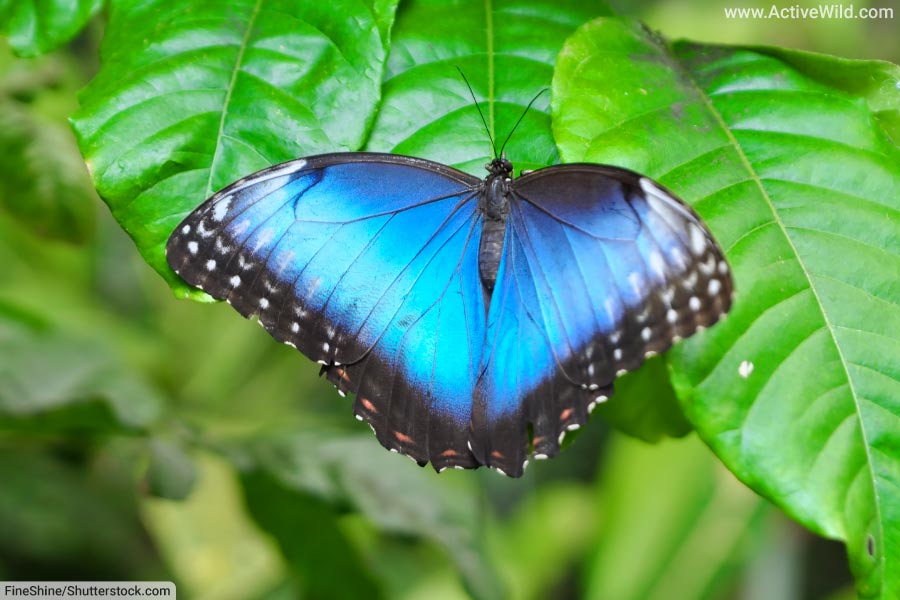
Butterflies are celebrated throughout the world for their bright colors and intricate patterns. Together with moths, they make up the insect order Lepidoptera, and these beautiful flying insects are found on all continents except Antarctica.
On this page is a list of the world’s most beautiful butterflies with pictures and facts.
Page Index
The Most Beautiful Butterflies In The World
Blue Morpho

Scientific Name: Morpho helenor
Family: Nymphalidae
Where Found: Central and South America
IUCN Conservation Status: Not Listed
The blue morpho is a rainforest butterfly known for the stunning iridescent blue color of its wings. With a wingspan of up to 20 cm / 7.9 in, the blue morpho is also one of the world’s largest butterflies.
The butterfly’s beautiful blue color is caused not by pigment, but by light reflecting off millions of microscopic scales and hairs in the insect’s wings. This is known as structural coloration, and is seen in most brightly-colored butterflies.
The butterfly’s coloration is thought to be a defense mechanism; a sudden flash of those bright blue wings may be enough to momentarily startle a potential predator, giving the blue morpho a chance to escape.
Native to neotropical habitats from southern North America to Argentina, the blue morpho prefers the sheltered environments of forest canopies. It feeds on fermenting fruits.
Morpho helenor is one of several related blue butterfly species known as blue morphos (an example of another is Morpho peleides). It itself has many subspecies.
Clipper
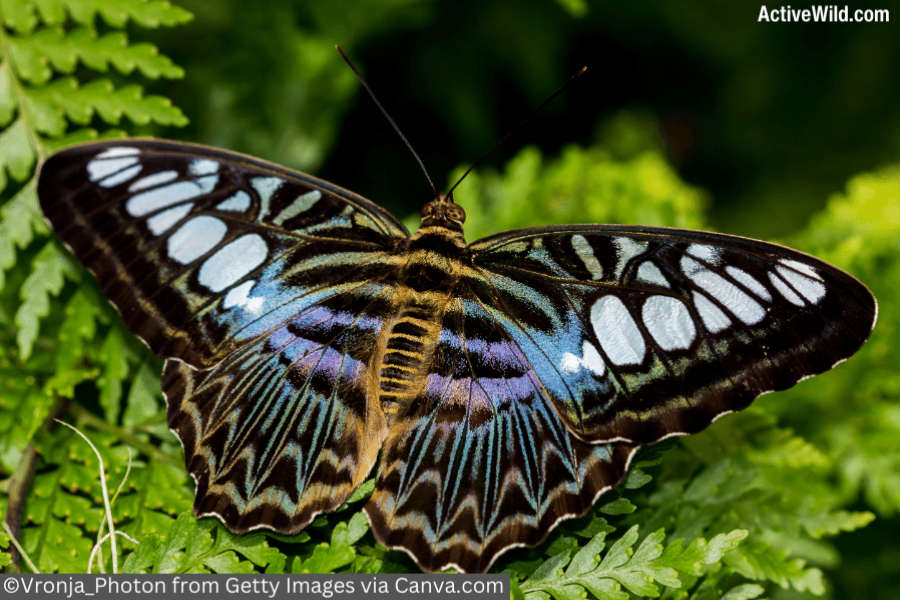
Scientific Name: Parthenos sylvia
Family: Nymphalidae
Where Found: Southeast Asia, Australia
IUCN Conservation Status: Not Listed
The clipper is a spectacular butterfly found across South and Southeast Asia. Its wings boast a striking pattern of colors that range from bright blue and green to deep browns.
Clippers are swift fliers, often found in forest clearings and around human habitations. Their caterpillars feed on host plants like Passiflora vines, and adults typically enjoy sipping on nectar.
Clippers are known for their alternating flapping and gliding flight pattern.
Comma
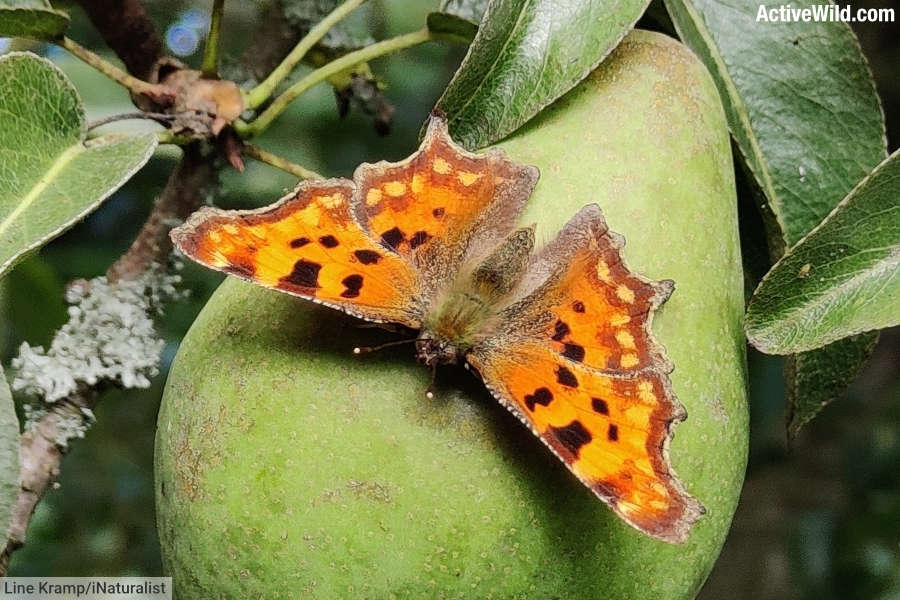
Scientific Name: Polygonia c-album
Family: Nymphalidae
Where Found: Europe and temperate Asia
IUCN Conservation Status: Least Concern
The Comma butterfly is a beautiful butterfly species easily identified by its ragged wing edges and distinct white ‘comma’ mark on the underside of the hindwings.
The comma is found in temperate regions of Europe and Asia, and is one of several species of genus Polygonia known as commas; others in the group include the Asian comma, Polygonia c-aureum, found in Asia, and the eastern comma, Polygonia comma, found in North America.
The comma, whose ragged, orange-brown wings provide excellent camouflage, is often found on nettle plants in its larval (caterpillar) stage.
Common Blue
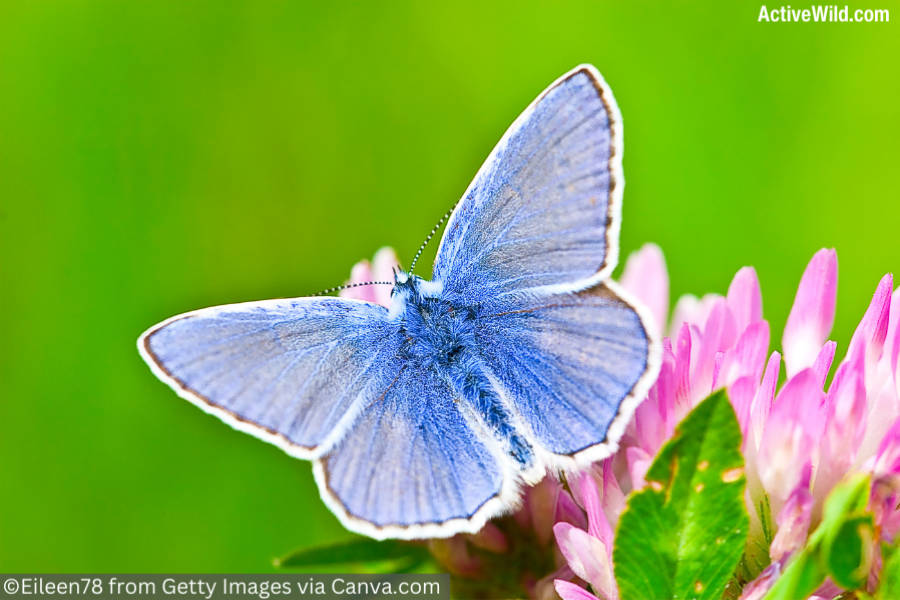
Scientific Name: Polyommatus icarus
Family: Lycaenidae
Where Found: Europe, North Africa, and temperate Asia
IUCN Conservation Status: Least Concern
The Common Blue is a small butterfly found in grasslands and meadows across Europe and Asia. The male is particularly beautiful, looking like a sparkling gem with its blue wings with white borders. The female is more subtle, with orange-brown wings bordered with orange spots.
The butterfly’s caterpillars typically feed on the common bird’s-foot trefoil, Lotus corniculatus, although other food plants are known.
Common Jezebel
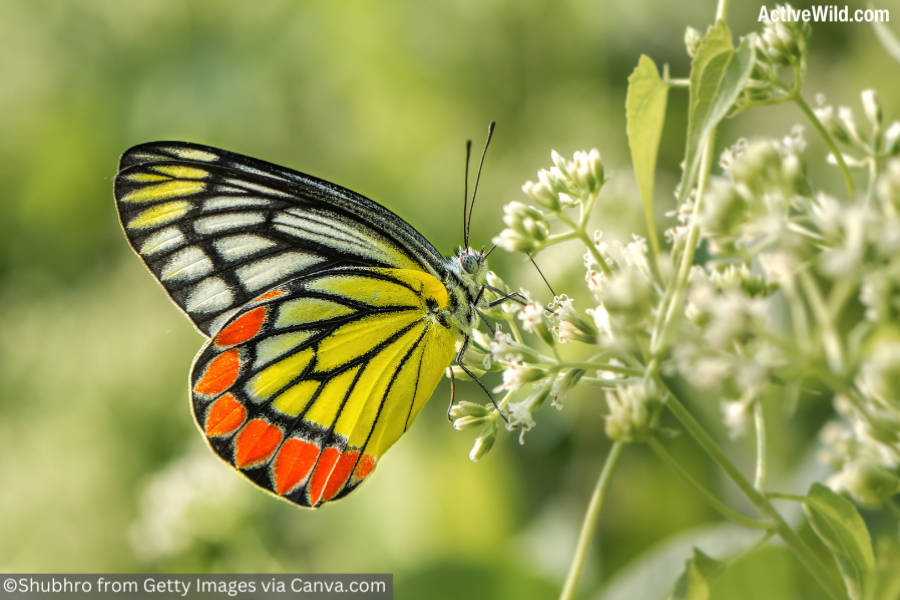
Scientific Name: Delias eucharis
Family: Pieridae
Where Found: South and Southeast Asia
IUCN Conservation Status: Not Listed
The common Jezebel is a medium-sized butterfly with vibrant yellow and red markings on a white background, framed by black borders.
Native to South and Southeast Asia, the common Jezebel is found in habitats ranging from rainforests to cities, and is a common visitor to gardens.
The species’ conspicuous coloration is aposematic, warning predators of its unpalatability. The butterfly flies high in the rainforest canopy, and the bright coloration of its underwings compared to the relatively plain appearance of the top of its wings may be an adaptation to warn birds flying below it.
Crimson Rose
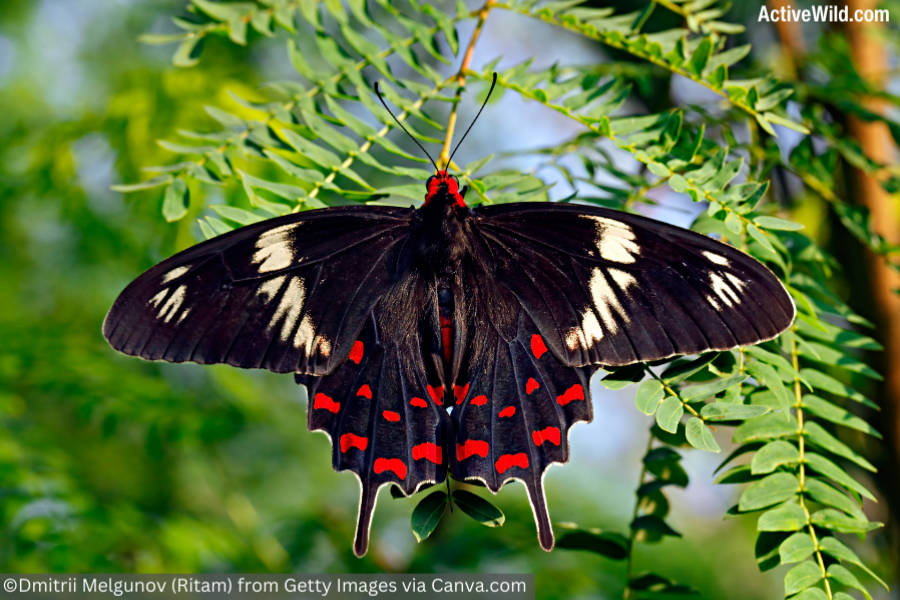
Scientific Name: Pachliopta hector
Family: Papilionidae
Where Found: South Asia
IUCN Conservation Status: Least Concern
The crimson rose is a beautiful south Asian butterfly with velvety black wings adorned with striking crimson patches. Its wingspan can reach up to 90-110 mm, and the species has a vivid red body.
This species belongs to the genus Pachliopta, a group known as the red-bodied swallowtails, a part of the swallowtail family, Papilionidae.
The crimson rose is found throughout much of India, as well as in Sri Lanka and the Maldives, and flourishes in a variety of habitats from sea level to mountainsides.
The butterfly’s bright coloration and distinctive flight pattern serve to warn potential predators that it is toxic; the species collects toxins from the plants it eats as a caterpillar. In its adult form it feeds on nectar from flowers.
(Eastern) Black Swallowtail
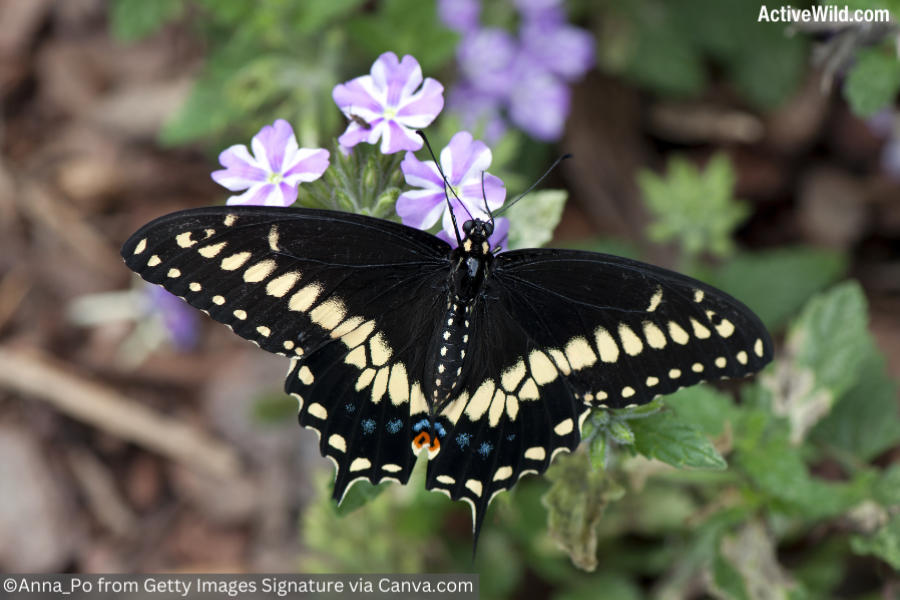
Scientific Name: Papilio polyxenes
Family: Papilionidae
Where Found: North America
IUCN Conservation Status: Least Concern
The eastern black swallowtail, also known as the black swallowtail or American swallowtail, has black wings punctuated by yellow spots and blue iridescence, with characteristic elongated tail extensions of all swallowtail butterflies.
This striking butterfly is widely distributed across North America, and can be found in open, sunny areas such as fields, gardens and parks. It prefers warm or tropical habitats.
Caterpillars are found on a variety of plants, including angelica, parsley, dill and fennel, making them a familiar sight for many gardeners.
As a defense, the larva possesses an osmeterium, a V-shaped organ at the front of the thorax that emits a foul smell to deter predators. (This is a characteristic of the larvae of all swallowtail butterflies.)
Glasswing Butterfly
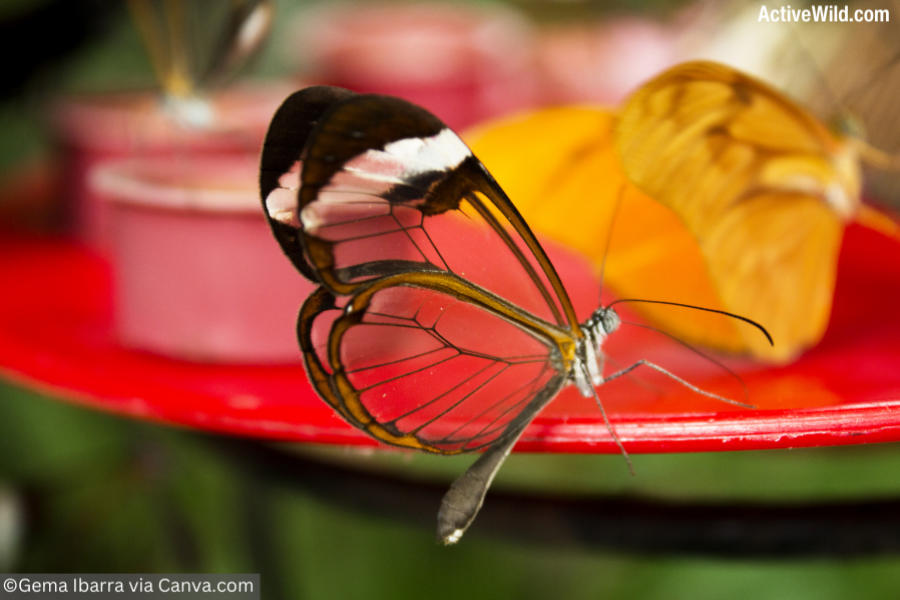
Scientific Name: Greta oto
Family: Nymphalidae
Where Found: Central and South America
IUCN Conservation Status: Not Listed
The glasswing butterfly is named for its translucent wings, which are an adaptation to conceal the insect from predators against a wide range of backgrounds.
The glasswing butterfly is typically found in rainforest habitats from Mexico south to Panama, but is occasionally seen as far north as Texas. It sips nectar from a variety of flowering plants, especially those of genus Lantana.
As a caterpillar, the glasswing butterfly feeds mainly on plants of genus Cestrum. Toxins in these plants make the butterfly poisonous to predators.
Gulf Fritillary
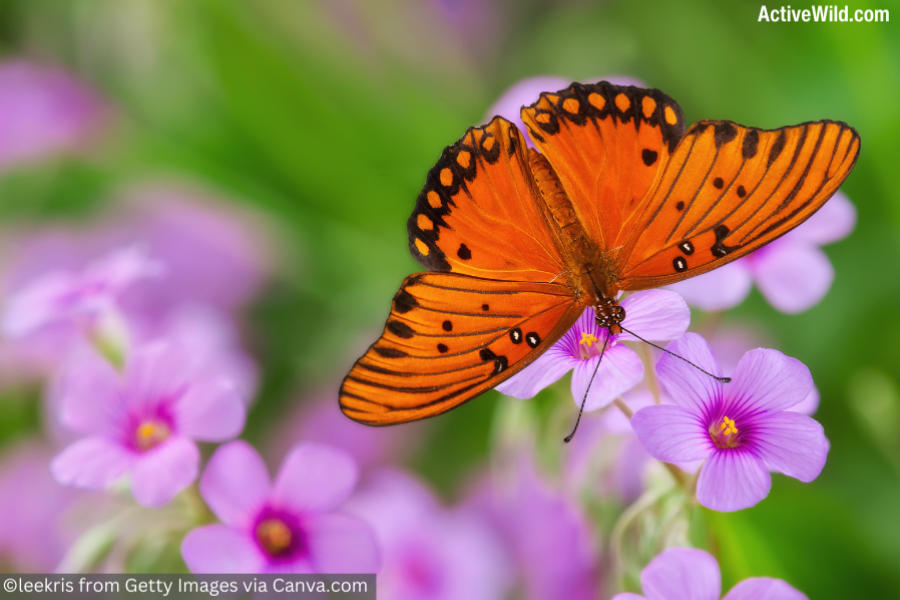
Scientific Name: Agraulis vanillae
Family: Nymphalidae
Where Found: Southern United States, Central America, and South America
IUCN Conservation Status: Least Concern
The Gulf Fritillary is a striking, medium-sized butterfly notable for its vibrant orange wings speckled with black spots. The undersides of its wings have distinctive silver markings.
This beautiful orange butterfly is found in the southeastern United States, Central America, and northern South America. It uses passion vines as host plants for its caterpillars. As an adult, it feeds on the nectar of Lantana plants.
The species’ caterpillars are bright orange with long, soft spines. Adults are commonly seen in various open habitats, including meadows, parks, and gardens.
Malachite
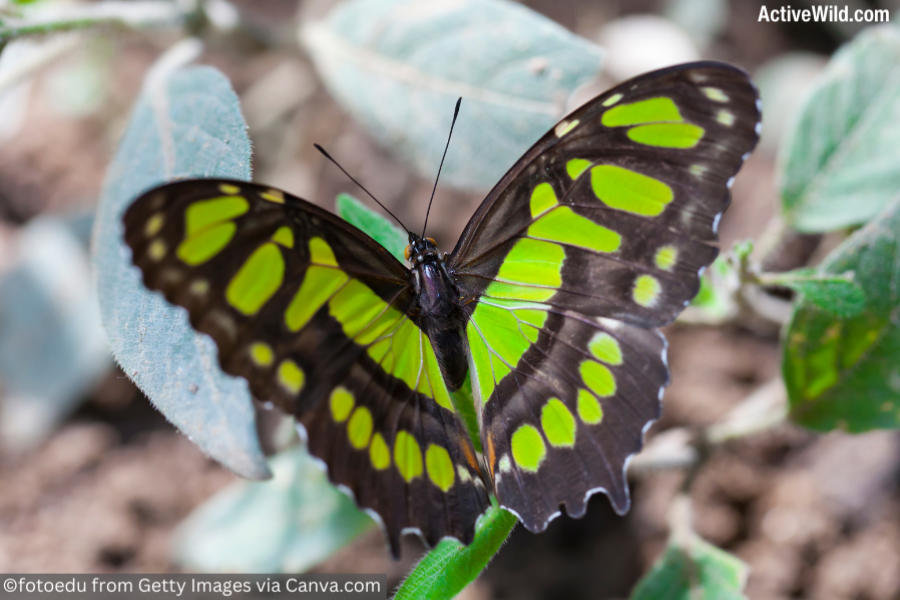
Scientific Name: Siproeta stelenes
Family: Nymphalidae
Where Found: Central and South America
IUCN Conservation Status: Not Listed
The Malachite is a beautiful neotropical butterfly with large wings with a unique mosaic of black and vivid green markings, reminiscent of the mineral malachite. This beautiful butterfly inhabits rainforests and secondary forests from South Texas to Brazil.
Malachites are often spotted fluttering in the dappled sunlight of the understory, where they feed on flower nectar, rotting fruit, and even bird droppings. Their caterpillars feed on plants from the Acanthaceae family.
Monarch
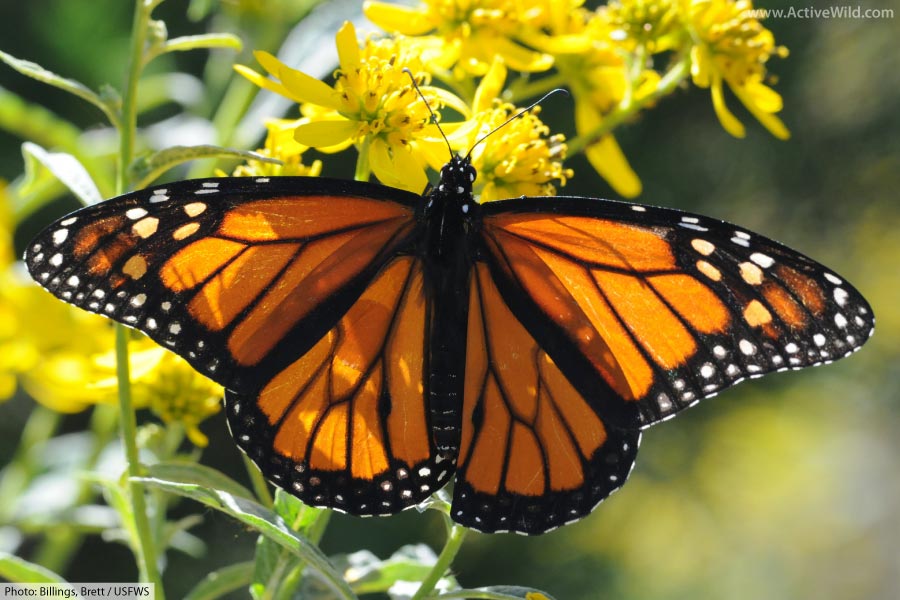
Scientific Name: Danaus plexippus
Family: Nymphalidae
Where Found: North America, Central America, South America, Australia, and some Pacific Islands
IUCN Conservation Status: Least Concern
The Monarch butterfly has vivid orange wings crisscrossed with black veins and edged with a black border speckled with white spots.
Males can be distinguished from females by the presence of a small black spot on each hind wing that releases pheromones, and veins that tend to be slightly thinner than those of the females.
Monarchs have a wingspan ranging from 8.9 to 10.2 centimeters / 3.5 to 4.0 inches, making them one of the larger butterfly species commonly found across North America.
The Monarch butterfly is renowned for its remarkable annual migration, traveling thousands of miles from North America to central Mexico and back, a journey that spans multiple generations.
Orange-Barred Sulphur
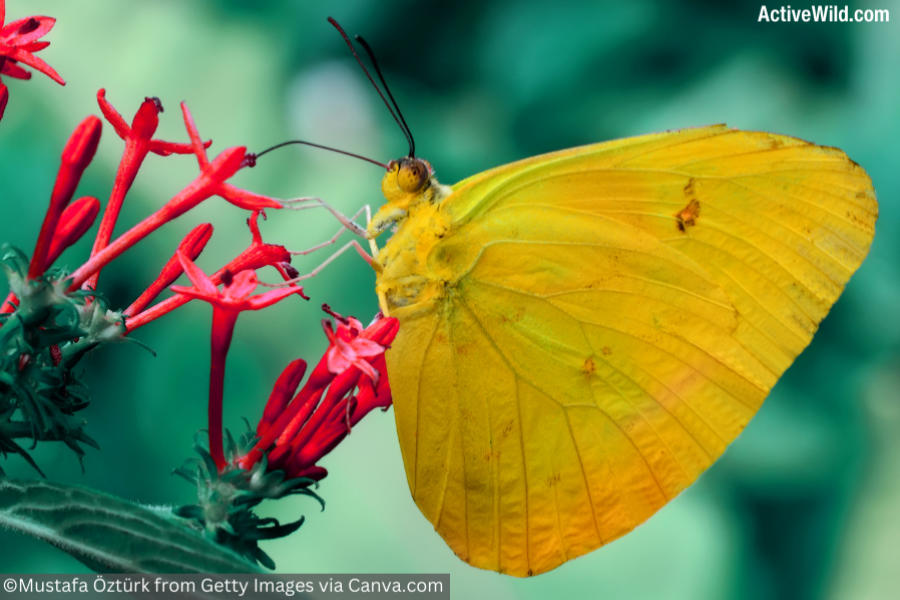
Scientific Name: Phoebis philea
Family: Pieridae
Where Found: Southern United States, Central America, and northern South America
IUCN Conservation Status: Not Listed
The orange-barred sulphur has vibrant yellow wings with distinctive orange bars on the upper side in males and duller yellow or greenish-white in females.
The wingspan of this eye-catching butterfly typically ranges between 68 and 80 millimeters, making it one of the larger species within the sulphur butterfly group.
The orange-barred sulphur is found in the southern United States, Mexico, Central America, and throughout northern South America.
Males of the species may be seen engaging in communal “mud-puddling” behavior, gathering on wet sand or mud to ingest essential minerals and salts.
Peacock Butterfly
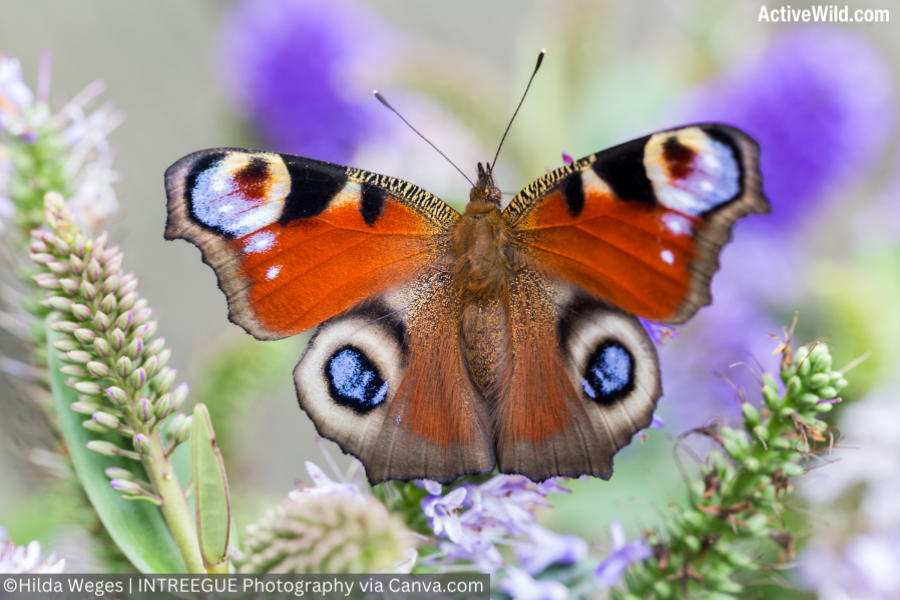
Scientific Name: Aglais io
Family: Nymphalidae
Where Found: Europe and temperate Asia
IUCN Conservation Status: Least Concern
The peacock butterfly has strikingly colorful wings adorned with vibrant eye-spots on a rich reddish-brown background. The eyespots are an adaptation for startling predators, giving the butterfly a chance to escape.
This beautiful butterfly is found across Europe and temperate Asia, in gardens, woodlands, and grassy areas where stinging nettles, its larval food plant, are plentiful. As an adult, it can be seen gathering nectar from plants such as buddleia.
Queen Alexandra’s Birdwing
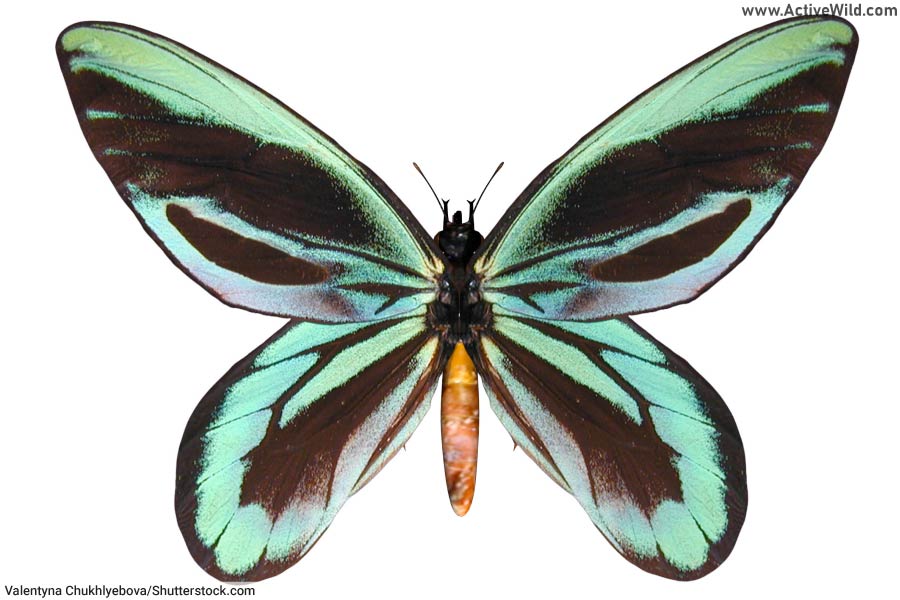
Scientific Name: Ornithoptera alexandrae
Family: Papilionidae
Where Found: Papua New Guinea
IUCN Conservation Status: Endangered
The Queen Alexandra’s birdwing is the largest butterfly in the world, with females boasting a wingspan up to 12 inches / 30 cm, significantly larger than the males. Its impressive wings are vibrant and colorful, with females displaying brown and white wings with yellow and blue accents, and males featuring a more striking electric blue and green pattern against a dark background.
The Queen Alexandra’s Birdwing butterfly is exclusively found in the lowland tropical rainforests of Oro Province in Papua New Guinea near the city of Popondetta. Its primary food plants are vines of genus Pararistolochia.
Red Admiral
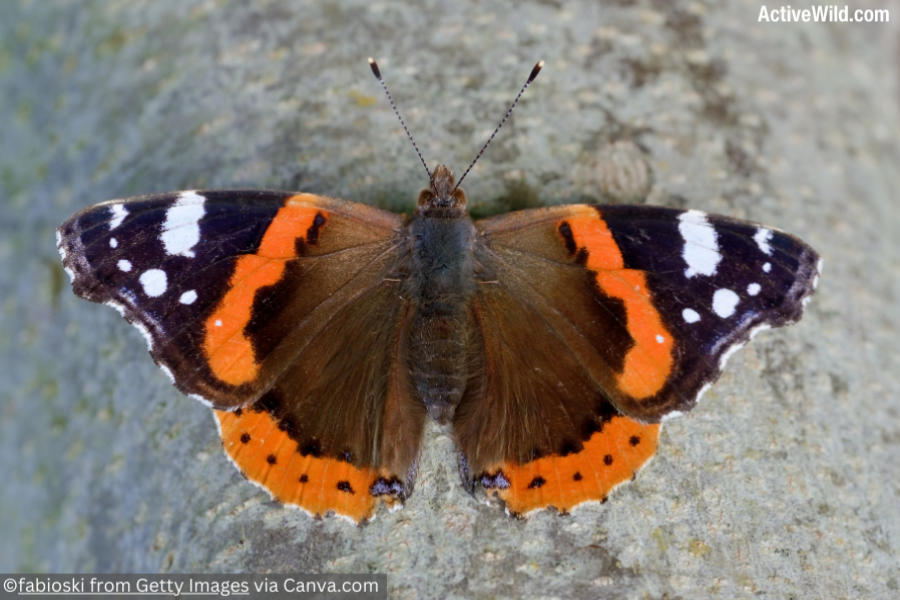
Scientific Name: Vanessa atalanta
Family: Nymphalidae
Where Found: North America, Europe, northern Africa, and Asia
IUCN Conservation Status: Least Concern
The red admiral is a medium-sized butterfly with striking black wings, marked by vibrant red bands and white spots, making it easily recognizable. Its wingspan typically ranges from about 45 to 50 millimeters (approximately 1.8 to 2.0 inches).
The butterfly is found across temperate regions of North America, Europe, Asia, and North Africa, thriving in a variety of habitats including woodlands, gardens, parks, and grassy areas, where its larval host plants like nettles and hops are available.
The red admiral is often one of the latest butterflies to be observed before the onset of winter.
Scarlet Swallowtail / Scarlet Mormon
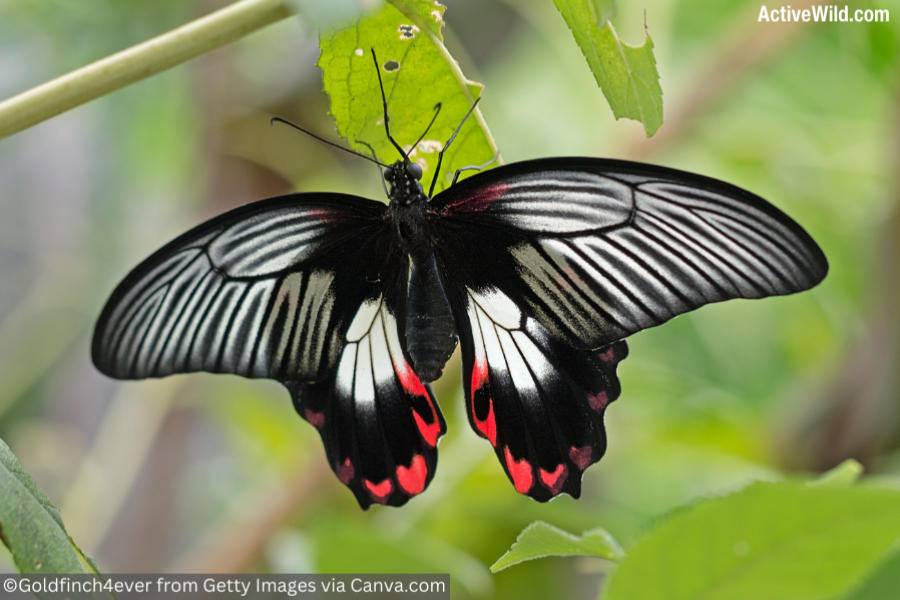
Scientific Name: Papilio rumanzovia
Family: Papilionidae
Where Found: Southeast Asia to northern Australasia
IUCN Conservation Status: Not Listed
The Scarlet Swallowtail (also known as the scarlet Mormon) is a striking butterfly with a deep red and black coloration.
The species has a considerable wingspan, generally measuring between 120 to 140 millimeters (about 4.7 to 5.5 inches), making it one of the larger species within the swallowtail family.
the Scarlet Swallowtail is found across Southeast Asia and the western Pacific regions, including the Philippines, Taiwan, and parts of Australia. It thrives in tropical and subtropical rainforests, often seen fluttering high in the canopy and occasionally descending to lower vegetation to feed or lay eggs. Its larvae feed on citrus plants.
Swallowtail
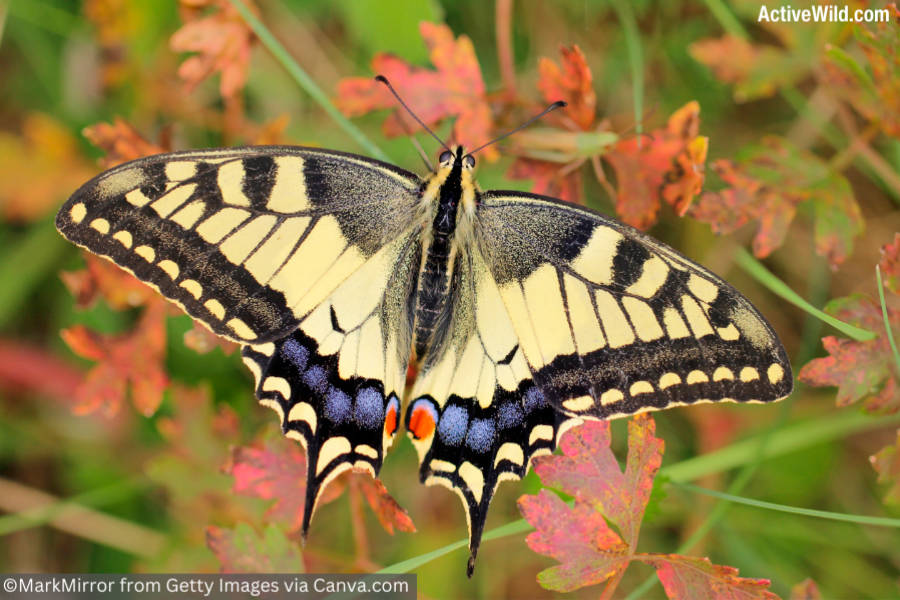
Scientific Name: Papilio machaon
Family: Papilionidae
Where Found: Europe, Asia, and North America
IUCN Conservation Status: Least Concern
The swallowtail is easily recognized by its large, vibrant yellow wings adorned with black vein markings and a series of blue and red spots near the tails of the hindwings. Its wingspan typically ranges from 65 to 86 millimeters (about 2.6 to 3.4 inches), featuring the characteristic tail-like extensions on the hindwings that give swallowtails their name.
The first of the swallowtails to be named, the species is also known as the Old World swallowtail to differentiate it from other swallowtails of family Papilionidae. It is one of the only swallowtails commonly seen in Europe.
The swallowtail has a broad range that extends across the northern hemisphere, including Europe, Asia, and North America. This species thrives in diverse habitats such as meadows, marshes, river valleys, and gardens, particularly where its larval host plants, including various species of the Apiaceae family like fennel and parsley, are abundant.
Ulysses Butterfly
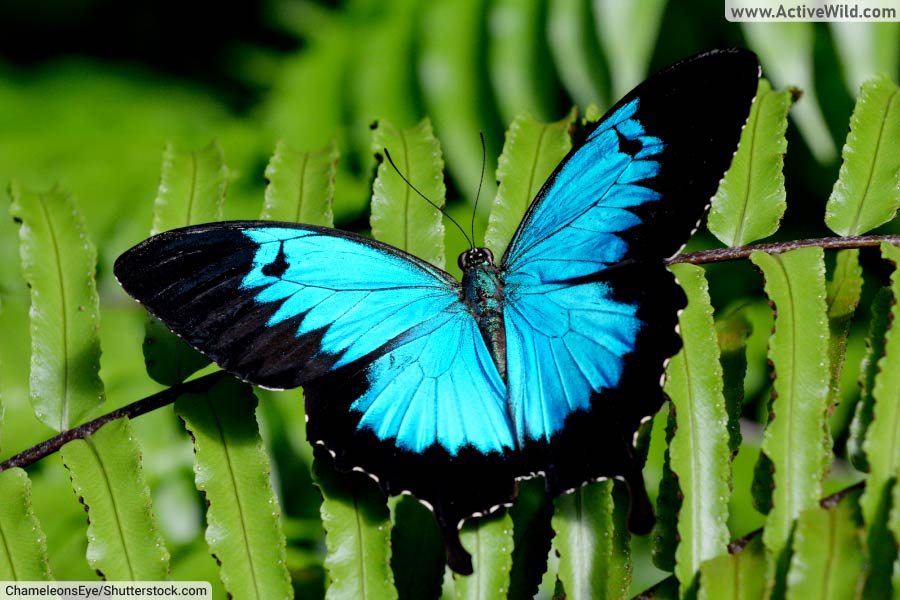
Scientific Name: Papilio ulysses
Family: Papilionidae
Where Found: Australasia
IUCN Conservation Status: Not Listed
One of Australia’s most beautiful butterflies, the Ulysses butterfly is known for its brilliant, iridescent blue wings, edged with black. Its wingspan is typically around 140 mm / 5.5 in. Typically for a swallowtail butterfly, each of its hindwings has a tail-like projection.
The Ulysses butterfly is predominantly found in the tropical rainforests of northern Australia, Papua New Guinea, Indonesia, and the Solomon Islands. It flourishes in moist, lush environments where it flutters high in the canopy, often descending to lower levels to feed on the nectar of flowering plants.
This beautiful blue butterfly is used as a tourist emblem for Queensland, Australia.
Zebra Longwing
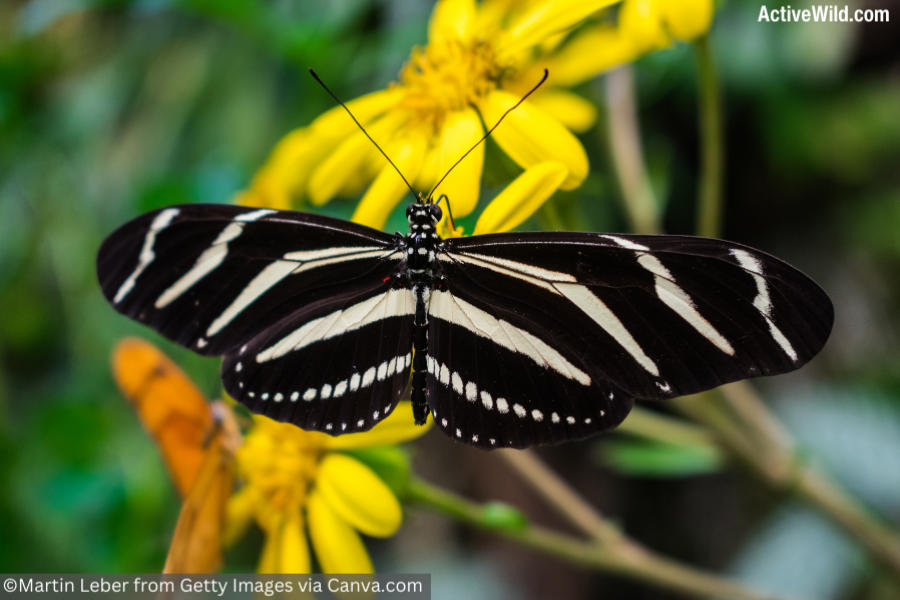
Scientific Name: Heliconius charithonia
Family: Nymphalidae
Where Found: Southern United States, Central America, and northern South America
IUCN Conservation Status: Not Listed
The zebra longwing has elongated wings with a distinctive pattern of yellow stripes on a black background, giving this beautiful butterfly a striking, zebra-like appearance.
The wingspan of this species typically ranges from 70 to 100 millimeters (about 2.8 to 4 inches), with its slender body and slow, graceful flight adding to its elegant demeanor.
The zebra longwing is found in the southern United States, south through Central America to the Amazon basin in South America. It is the state insect of Florida.
This striking butterfly thrives in warm, tropical and subtropical environments, frequenting a variety of habitats including hardwood hammocks (areas of closed canopy forest), gardens, and along forest edges. As an adult, it feeds on both pollen and nectar. As a caterpillar, its host plants are several species of passionflowers.
Zebra Swallowtail
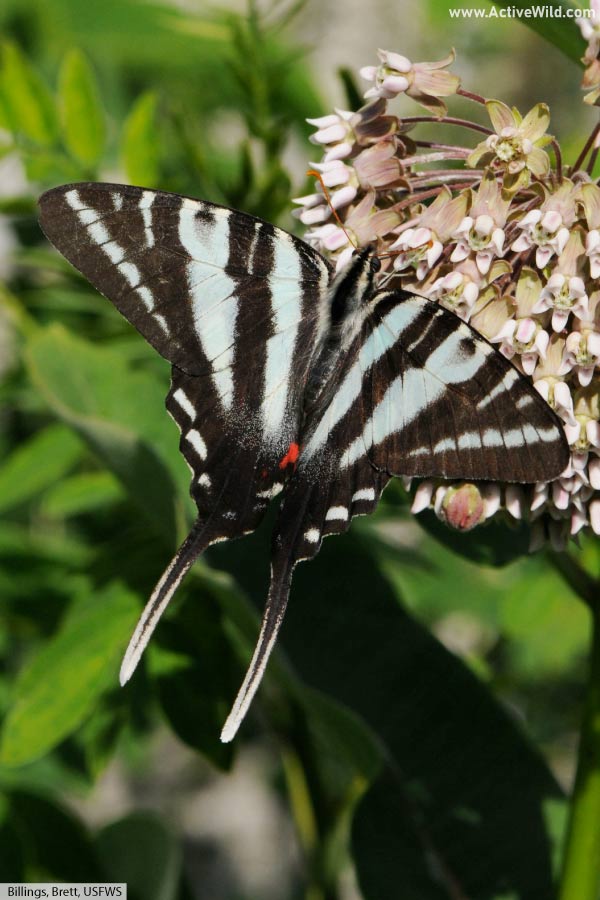
Scientific Name: Protographium marcellus
Family: Papilionidae
Where Found: Southeastern United States
IUCN Conservation Status: Not Listed
The zebra swallowtail is easily recognizable by its pale white wings marked with black zebra-like stripes and patches of red and blue. Like other swallowtail butterflies, it has long, tail-like extensions on its hindwings.
This distinctive butterfly typically has a wingspan ranging from 6 to 10 centimeters (about 2.4 to 4 inches).
The zebra swallowtail is primarily found in the eastern United States, particularly from Florida to southern Ontario, and is the state butterfly of Tennessee.
The preferred habitat of the zebra swallowtail includes moist woodland areas near rivers or swamps, where its larval host plant, the pawpaw tree, is abundant.
Why Do Butterflies Have Brightly-Colored Wings?
Like everything in nature, a butterfly’s bright colors aren’t just for show; the colors and patterns are adaptations that have evolved to serve numerous biological purposes.
A butterfly’s colors can act as a mechanism for heat absorption or reflection, keeping the butterfly operating at the correct temperature, allowing it to get on with the important things in life, such as feeding and reproduction.
A butterfly’s wings often play a key role in communication and survival. Bright colors can be a warning signal, a phenomenon known as aposematism, that signals to predators that the butterfly is potentially toxic or foul-tasting.
Mimicry, another survival strategy, is when butterflies have evolved to imitate the appearance of other, more dangerous species. The eye-like markings known as eyespots on the wings of many butterfly species mimic the eyes of larger animals to scare away potential predators.
Eyespots and brightly-colored wings can also be quickly flashed to startle or confuse potential predators; a strategy known as deimatic behavior.
The colors and patterns can aid in mating rituals, attracting partners with specific visual cues that signify fitness and species identity.
Discover More With Active Wild
Find out more about butterflies on thee following pages:
Discover the difference between moths and butterflies: Moth Vs Butterfly
You can find out more about insects on this page: Insects – The Ultimate Guide
Discover more invertebrates on this page: List Of Invertebrates
Become an expert on the entire animal kingdom: Animals – The Ultimate Guide
The post The World’s Most Beautiful Butterflies: Pictures & Facts appeared first on Active Wild.